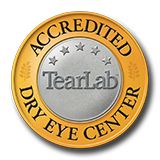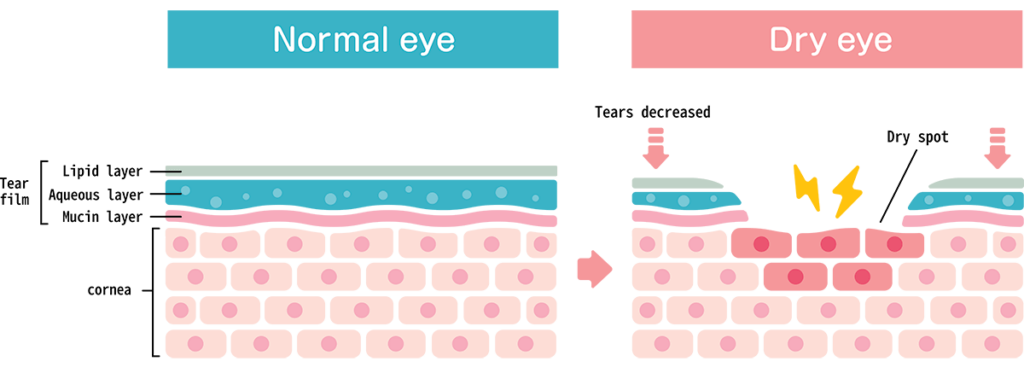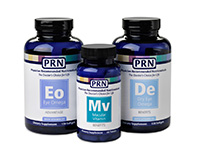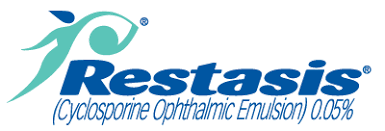Dry Eye Services New Hampshire
People who suffer from Dry Eye Syndrome (DES) or Ocular Surface Disease, complain of constant burning or stinging in their eyes. They may not have problems with tearing up at life’s emotional moments, but day to day, people with DES have difficulties with moisture in the eyes. Almost 12 million Americans suffer from this condition. The most common symptoms include pain from eye irritation; a sandy or gritty sensation; decreased tolerance to contact lenses; and sensitivity to light. In early stages, the symptoms may seem to appear and disappear, but generally worsen as the day progresses.
So what is Dry Eye Syndrome?
The surface of your eye is covered with a tear film layer that functions as a moisture barrier, protecting the eye from airborne debris and chemicals by flushing these contaminants from the eye. This layer is refreshed each time you blink. If your tear film is functioning irregularly then you are without its protection which may lead to problems such as blurred vision, irritation or scratchy sensations, burning, redness, intermittent tearing, and light sensitivity.
Dry Eye Treatment Portsmouth
There are many things that can lead to DES, including environmental conditions, eyelid disorders, systemic diseases such as rheumatoid arthritis, lupus, and sarcoid, increasing age, some medications and nutritional deficiencies. There are many causes of dry eyes. Aging is certainly a factor; as people age, they secrete fewer tears, leading to dryness. Hormone depletion undoubtedly plays a role, as dry eyes are also more common in women than men, especially post-menopausal women. The tear film is made up of three layers; the lipid layer- thin and oily, the aqueous layer providing oxygen and nutrients, and the inner most layer which coats the eye with a substance called mucin that enables tears to stick to the eye’s surface.
Treatments and Solutions
Dry eye has no definitive cure, but the symptoms can be treated based on what is causing your dry eyes. Our highly trained staff and dry eye providers will work with you to provide relief and comfort. Treatments include artificial tear eye drops, Punctal plugs, Restasis, Omega-3 Herbal Supplements and Lipiflow all of which can bring relief to dry eyes.
Eye Drops
The most popular and widely available of all dry eye treatment is supplemental lubrication, or artificial tears to improve to poor tear film on the surface of the eye. There are many types and brands of lubricating eye medications. Over-the-counter artificial tears can provide quick but temporary symptom relief and help lubricate eyes.
Most generic or store name brands have preservatives that can aggravate the condition, and can even kill corneal cells making your dry eyes worse. Tears that promise to “get the red out” may reduce circulation in the eye, decrease production of the tear film, and eventually make your eyes even drier.
Nutritional Suppliments
Herbal Supplements can effect tear quality, which is crucial for good eye health. Poor tear quality can cause a number of issues from eye pain to impaired vision. Improving the omega-3-lipid component of the tear leads to better tear composition and better lubrication for the eye. In a study published in the American Journal of Clinical Nutrition, women who maintained a daily intake of omega-3s EPA and DHA in a natural triglyceride form reduced the risk of Dry Eye Syndrome by up to 66%.
Choosing to take an omega-3 will provide your body the necessary nutrients for optimal tear composition and overall eye health. PRN (Physician Recommended Nutriceuticals) partners with doctors to provide the purest, evidence-based, and most therapeutically potent omega-3 products to improve eye health.
Restasis and Xiidra
These are prescription eye drops that may be recommended for daily use to treat dry eyes. Restasis is intended to help increase your eye’s natural ability to produce tears in cases where it may be reduced due to inflammation from chronic dry eyes. Xiidra’s effects are generally felt within a few weeks.
Punctal plugs
Keeping the natural tears on the surface of the eye longer is another treatment option for dry eyes. Small silicone plugs can be placed in the puncta (drainage canals) to prevent tears from draining from the eyes. These plugs can be removed if necessary. There is also a surgical procedure to permanently close the puncta.
TearLab
At Eyesight Ophthalmology Services, we are proud to offer the TearLab Osmolarity System, which is the first objective test for diagnosing and managing Dry Eye patients. This cutting-edge technology enables our doctors to provide fast and accurate results in seconds using only 50 nanoliters (nl) of tear film to diagnose Dry Eye Disease.
By incorporating osmolarity into the standard of care, we can better assess problems and provide solutions for early stage Dry Eye Syndrome. This test provides an objective measurement of the salt concentration in the tears, which can help us identify patients who are at risk for developing Dry Eye Disease or those who may have early stage symptoms.
With this information, we can work with our patients to develop a customized treatment plan that may include the use of artificial tears, prescription medications, or other therapies to help alleviate their symptoms. By using the TearLab Osmolarity System, we can monitor our patients’ progress and adjust their treatment plan as needed to ensure the best possible outcomes.
LipiScan
Many people suffer from dry eye due to meibomian gland dysfunction, also known as MGD. MGD causes your tears to rapidly evaporate. The LipiScan and LipiFlow accurately diagnose and treat MGD. The FDA approved LipiFlowsystemdirectly treats the meibomian glands by using gentle massage and heat to improve the secretions from the glands and remove blockage. This dropless system can often help patients avoid the inconvenience of daily eyedrops. This comfortable 15 minute in office procedure can be done repeatedly if needed.
Blepharitis
Blepharitis is inflammation of the eyelid and is usually caused by bacterial eye infection, dry eye syndrome and certain types of skin conditions such as acne rosacea
Blepharitis has two basic forms:
- Anterior blepharitis, affecting the outside front of the eyelid where eyelashes are attached.
- Posterior blepharitis, which is a dysfunction of meibomian glands. Meibomian glands are found within the eyelids and secrete oils to help lubricate the eye.
Common symptoms of blepharitis include tearing, dry eyes, crusty eyelids, redness and inflammation, itchy or scratchy eyes and the feeling of a foreign body sensation. Blepharitis is a very common diagnosis. Semi-effective treatments usually include warm compresses, lid scrubs, punctual plugs and/or certain types of eye drops.
Eyesight is proud to offer BlephEx for those suffering from blepharitis. The BlephEx system utilizes patented hand piece containing a spinning medical grade micro sponge that is passed along the edge of the eyelids and lashes, removing scurf and debris and exfoliating the eyelids.
The BlephEx treatment will reduce and alleviate the symptoms associated with blepharitis. Treatments are generally conducted in monthly intervals depending on the severity of the disease. By eliminating the etiology of start producing more of their own tears.
Interested in scheduling a time to meet with our Ocular Surface Management specialists? Dr. Lauren McLoughlin and Dr. Renee Lynch are seeing patients in our Somersworth and Exeter locations. Our scheduling department can arrange this for you by calling 603-436-1773.
Once an appointment has been scheduled, we encourage you to complete our Dry Eye Questionnaire and bring it with you to your appointment. This will help our providers understand the severity of your condition in an effort to start planning on a treatment.
How is dry eye treated using IPL?
Intense Pulsed Light (IPL) therapy has been used as a treatment option for dry eyes, particularly for patients with evaporative dry eyes caused by meibomian gland dysfunction (MGD). IPL therapy uses pulses of light to heat the oil-producing glands in the eyelids, which can help improve the quality and quantity of the oil produced, thus preventing the tears from evaporating too quickly.
During an IPL treatment for dry eye, the patient is given protective eyewear to wear, and a cooling gel is applied to the skin around the eyes. The IPL device emits pulses of light, which are directed at the eyelids to target the meibomian glands. IPL therapy for dry eye has been shown to improve symptoms such as dryness, burning, and redness and to increase tear production.
Frequently Asked Questions about IPL:
Are you ready to get rid of dry eyes? Contact us today to schedule your consultation with one of our dry eye specialists.






